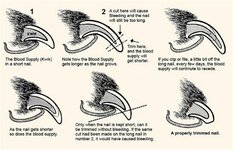If not trimmed regularly, the dog's nails will get longer, but it's important to keep in mind that the quick will get longer too, so if a dog's nails have been allowed to get long you can't just cut them short without causing pain. You'll need to trim them to near the end of the quick and keep at it, trimming on a more frequent scedule (perhaps weekly for a while) and the quick will recede slowly back to it's usual position. I prefer nails trimmed so that I do not hear the nails clacking on flooring and the clickity-clack is my signal that it's time to trim.
I find it handy to stop periodically and feel the end of the nail with a finger nail. If I can press on the end of the dog's nail with my fingernail and not feel any give, I will sand more, but as you approach the quick the end of the nail will begin to soften and you will feel some give to it, you don't want to go much farther than that or you'll get into the quick and cause pain.
As stated I use a rotary tool, a nice benefit is that you don't end up with the rough edges most guillotine type cutters will leave.
People with long haired dogs should be aware that you may need to trim the hair around the toes and be careful to ensure no hair is allowed to get entangled in the tool, it will quicly wrap around the drum and be unpleasant for the dog. Trim the hair, use care and planning to work around it keeping *all* loose hair secured and away, or use a manual cutter and a nail file.
View attachment 323804



